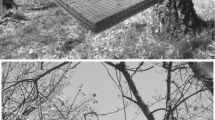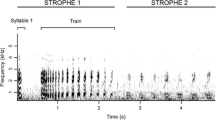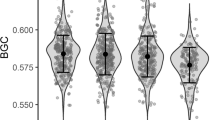Abstract
In the European starling, Sturnus vulgaris, optimal mating systems differ between males and females. Males gain from polygyny, whereas monogamy increases female fitness. The cost of polygyny to females lead to intense female–female competition, and it has previously been shown that the intensity of female aggression during the pre-breeding period can predict the realised mating system. The physiological regulation of such female aggression in starlings is not yet known. This study examines the role of testosterone in mediating aggressive behaviours involved in intra-specific reproductive competition in female starlings. Testosterone levels were experimentally elevated with testosterone implants in females during the pre-laying period. To simulate a situation in which an additional female tried to mate with the focal female’s mate, a caged female was presented close to a nest-site to which the male could attract a secondary female. Testosterone was significantly related to several behaviours involved in female–female interactions. Females with testosterone implants spent significantly more time close to the caged female and produced more song bouts than control females. In contrast, male behaviour was unrelated to the experimental status of the mate. Females mated to males that attracted a secondary female were less aggressive towards the caged female than those that remained monogamously mated. The effect of exogenous testosterone in this study indicates that androgens may mediate social behaviours in female starlings during the breeding season.


Similar content being viewed by others
References
Andersson M (1994) Sexual selection. Princeton University Press, Princeton, NJ, p xx + 599pp
Beletsky LD, Orians GH, Wingfield JC (1990) Effects of exogenous androgen and antiandrogen on territorial and nonterritorial red-winged blackbirds (Aves: Icterinae). Ethology 85:58–72
Beletsky LD, Gori DF, Freeman S, Wingfield JC (1995) Testosterone and polygyny in birds. Curr Ornithol 12:1–41
Bensch S, Hasselquist D (1994) Higher rate of nest loss among primary than secondary females: Infanticide in the great reed warbler? Behav Ecol Sociobiol 35:309–317
Bradley FC, Stutchbury BJM (2005) Territory defence in tropical birds: are females as aggressive as males? Behav Ecol Sociobiol 58:414–422
Brown CR, Brown MB, Raouf SA, Smith LC, Wingfield JC (2005) Effects of endogenous steroid hormone levels on annual survival in Cliff Swallows. Ecology 86:1034–1046
Bruun M, Sandell MI, Smith HG (1997) Polygynous male starlings allocate parental effort according to relative hatching date. Anim Behav 54:73–79
Casto JM, Ball GF (1996) Early administration of 17-beta-estradiol partially masculinizes song control regions and alpha-2-adrenergic receptor distribution in European starlings (Sturnus vulgaris). Horm Behav 30:387–406
Clotfelter ED, O’Neal DM, Gaudioso JM, Casto JM, Parker-Renga IM, Snajdr EA, Duffy DL, Nolan V Jr, Ketterson ED (2004) Consequences of elevating plasma testosterone in females of a socially monogamous songbird: evidence of constraints on male evolution? Horm Behav 46:171–178
Conover WJ, Iman RL (1981) Rank transformation test as a bridge between parametric and nonparametric statistics. Am Stat 35:124–129
Cristol DA, Johnsen TS (1994) Spring arrival, aggression and testosterone in female red-winged blackbirds (Agelaius phoeniceus). Auk 111:210–214
Dawson A (1994) The effects of daylength and testosterone on the initiation and progress of moult in Starlings Sturnus vulgaris. Ibis 136:335–340
De Ridder E, Pinxten R, Eens M (2000) Experimental evidence of a testosterone-induced shift from paternal to mating behaviour in a facultatively polygynous songbird. Behav Ecol Sociobiol 49:24–30
De Ridder E, Pinxten R, Mees V, Eens M (2002) Short- and long-term effects of male-like concentrations of testosterone on female European Starlings (Sturnus vulgaris). Auk 119:487–497
Duffy DL, Bentley GE, Drazen DL, Ball GF (2000) Effects of testosterone on cell-mediated and humoral immunity in non-breeding adult European starlings. Behav Ecol 11:654–662
Eens M (1997) Understanding the complex song of the European starling: an integrated ethological approach. Adv Study Behav 26:355–434
Eens M, Van Duyse E, Berghman L, Pinxten R (2000) Shield characteristics are testosterone-dependent in both male and female moorhens. Horm Behav 37:126–134
Elekonich MM, Wingfield JC (2000) Seasonality and hormonal control of territorial aggression in female song sparrows. Ethology 106:493–510
Goymann W, Wingfield JC (2004) Competing females and caring males. Sex steroids in African black coucals, Centropus grillii. Anim Behav 68:733–740
Gwinner E (1975) Effects of season and external testosterone on the free running circadian activity rhythm of European starlings Sturnus vulgaris. J Comp Phys A 103:315–328
Hau M, Wikelski M, Soma KK, Wingfield JC (2000) Testosterone and year-round territorial aggression in a tropical bird. Gen Comp Endocrinol 117:20–33
Hausberger M, Henry L, Richard MA (1995) Testosterone-induced Singing in female European starlings (Sturnus vulgaris). Ethology 99:193–208
Hegner RF, Wingfield JC (1987) Social status and circulating levels of hormones in flocks of house sparrows, Passer domesticus. Ethology 76:1–14
Jawor JM, Young R, Ketterson ED (2006) Females competing to reproduce: dominance matters but testosterone may not. Horm Behav 49:362–368
Karlsson J (1983) Breeding of the starling. Ph.D. Thesis. Lund University, Sweden
Ketterson ED, Nolan V Jr, Wolf L, Ziegenfus C (1992) Testosterone and avian life histories: effects of experimentally elevated testosterone on behavior and correlates of fitness in the dark-eyed junco (Junco hyemalis). Am Nat 140:980–999
Ketterson ED, Nolan V, Sandell M (2005) Testosterone in females: mediator of adaptive traits, constraint on sexual dimorphism, or both? Am Nat 166:S85–S98
Kriner E, Schwabl H (1991) Control of winter song and territorial aggression of female Robins (Erithacus rubecula) by testosterone. Ethology 87:37–44
Lande R, Arnold SJ (1983) The measurement of selection on correlated characters. Evolution 37:1201–1226
Langmore NE, Cockrem JF, Candy EJ (2002) Competition for male reproductive investment elevates testosterone levels in female dunnocks, Prunella modularis. Proc R Soc Lond B 269:2473–2478
Liker A, Szekely T (1997) Aggression among female lapwings, Vanellus vanellus. Anim Behav 54:797–802
Martin R, Bateson P (1986) Measuring behaviour. Cambridge University Press, Cambridge
Mazuc J, Bonneaud C, Chastel O, Sorci G (2003) Social environment affects female and egg testosterone levels in the house sparrow (Passer domesticus). Ecol Lett 6:1084–1090
Moller AP, Garamszegi LZ, Gil D, Hurtrez-Bousses S, Eens M (2005) Correlated evolution of male and female testosterone profiles in birds and its consequences. Behav Ecol Sociobiol 58:534–544
Pinxten R, Eens M (1990) Polygyny in the European starling; effect on female reproductive success. Anim Behav 40:1035–1047
Rhen T, Ross J, Crews D (1999) Effects of testosterone on sexual behavior and morphology in adult female leopard geckos, Eublepharis macularius. Horm Behav 36:119–128
Rubenstein DR, Wikelski M (2005) Steroid hormones and aggression in female Galapagos marine iguanas. Horm Behav 48:329–341
Rutkowska J, Cichon M, Puerta M, Gil D (2005) Negative effects of elevated testosterone on female fecundity in zebra finches. Horm Behav 47:585–591
Sandell MI (1998) Female aggression and the maintenance of monogamy: female behaviour predicts male mating status in European starlings. Proc R Soc Lond B 265:1307–1311
Sandell MI, Smith HG (1996) Already mated females constrain male mating success in the European starling. Proc R Soc Lond B 263:743–747
Sandell MI, Smith HG (1997) Female aggression in the European starling during the breeding season. Anim Behav 53:13–23
Sandell MI, Smith HG, Bruun M (1996) Paternal care in the European starling, Sturnus vulgaris: nestling provisioning. Behav Ecol Sociobiol 39:301–309
Schlinger BA, Callard GV (1990) Aromatization mediates aggressive behavior in quail. Gen Comp Endocrinol 79:39–53
Schwabl H, Kriner E (1991) Territorial aggression and song of male European Robins Erithacus rubecula in autumn and spring effects of antiandrogen treatment. Horm Behav 25:180–194
Schwabl H, Flinks H, Gwinner E (2005) Testosterone, reproductive stage, and territorial behavior of male and female European stonechats Saxicola torquata. Horm Behav 47:503–512
Searcy WA (1988) Do female red-winged blackbirds limit their own breeding densities. Ecology 69:85–95
Silverin B (1980) Effects of long-acting testosterone treatment on free-living pied flycatchers, Ficedula hypoleuca, during the breeding period. Anim Behav 28:906–912
Silverin B, Baillien M, Balthazart J (2004) Territorial aggression, circulating levels of testosterone, and brain aromatase activity in free-living pied flycatchers. Horm Behav 45:225–234
Slagsvold T, Lifjeld JT (1994) Polygyny in birds: The role of competition between females for male parental care. Am Nat 143:59–94
Slagsvold T, Dale S, Lampe HM (1999) Does female aggression prevent polygyny? An experiment with pied flycatchers (Ficedula hypoleuca). Behav Ecol Sociobiol 45:403–410
Smith HG (2004) Selection for synchronous breeding in the European starling. Oikos 105:301–311
Smith HG, Sandell MI (1998) Intersexual competition in a polygynous mating system. Oikos 83:484–495
Smith HG, Ottosson U, Sandell M (1994) Intrasexual competition among polygynously mated female starlings (Sturnus vulgaris). Behav Ecol 5:57–63
Smith HG, Sandell MI, Bruun M (1995) Paternal care in the European starling, Sturnus vulgaris: incubation. Anim Behav 50:323–331
Smith HG, Sandell MI (2005) The starling mating system as an outcome of the sexual conflict. Evol Ecol 19:151–165
Soma KK, Sullivan KA, Wingfield JC (1999) Combined aromatase inhibitor and antiandrogen treatment decreases territorial aggression in wild songbird during the non-breeding season. Gen Comp Endocrinol 115:442–453
Soma KK, Tramontin AD, Wingfield JC (2000) Oestrogen regulates male aggression in the non-breeding season. Proc R Soc Lond B 267:1089–1096
Staub NL, De Beer M (1997) The role of androgens in female vertebrates. Gen Comp Endocrinol 108:1–24
Trainor BC, Bird IM, Marler CA (2004) Opposing hormonal mechanisms of aggression revealed through short-lived testosterone manipulations and multiple winning experiences. Horm Behav 45:115–121
Veiga JP, Vinuela J, Cordero PJ, Aparicio JM, Polo V (2004) Experimentally increased testosterone affects social rank and primary sex ratio in the spotless starling. Horm Behav 46:47–53
Verheyen RF (1969) Le choix du nichoir ches l’etourneau, Sturnus v.vulgaris. Gerfaut 59:239–259
Whittingham LA, Dunn PO (2001) Female responses to intraspecific brood parasitism in the Tree Swallow. Condor 103:166–170
Whittingham LA, Schwabl H (2002) Maternal testosterone in tree swallow eggs varies with female aggression. Anim Behav 63:63–67
Wingfield JC (1994) Hormone behavior interactions and mating systems in male and female birds. In: Short RV, Balaban E (eds) The difference between the sexes. Cambridge University Press, Cambridge
Wingfield JC, Moore IT, Goymann W, Wacker D, Sperry T (2005) Contexts and ethology of vertebrate aggression: implications for the evolution of hormone-behaviour interactions. In: Nelson R (ed) Biology of aggression. Oxfords University Press, Oxford
Wittenberger JF (1981) Male quality and polygyny the sexy son hypothesis revisited. Am Nat 117:329–342
Wittenberger JF, Tilson RL (1980) Evolution of monogamy hypotheses and evidence. Ann Rev Ecol Syst 11:197–232
Woodley SK, Moore MC (1999) Ovarian hormones influence territorial aggression in free-living female mountain spiny lizards. Horm Behav 35:205–214
Yasukawa K, Searcy WA (1981) Nesting synchrony and dispersion in red-winged blackbirds Agelaius phoeniceus is the harem competitive or cooperative. Auk 98:659–668
Zysling DA, Greive TJ, Breuner CW, Casto JM, Dernas GE, Ketterson ED (2006) Behavioral and physiological responses to experimentally elevated testosterone in female dark-eyed juncos (Junco hyemalis carolinensis). Horm Behav 50:200–207
Acknowledgements
Kent Andersson provided excellent help during the cage experiment, and Martin Granbom, Michael Tobler, Måns Bruun and Henrik Smith assisted during field work. Michael Tobler and Henrik Smith provided useful comments on the manuscript. The study was financed by grants from the Swedish Research Council (VR) and Kungliga Fysiografiska Sällskapet. The methods adhere to the Guide for the Care and Use of Laboratory Animals in Sweden (Djurskyddsmyndigheten) and were approved by the Malmö/Lund Animal Care Committee (Sweden).
Author information
Authors and Affiliations
Corresponding author
Additional information
Communicated by P. Heeb
Rights and permissions
About this article
Cite this article
Sandell, M.I. Exogenous testosterone increases female aggression in the European starling (Sturnus vulgaris). Behav Ecol Sociobiol 62, 255–262 (2007). https://doi.org/10.1007/s00265-007-0460-9
Received:
Revised:
Accepted:
Published:
Issue Date:
DOI: https://doi.org/10.1007/s00265-007-0460-9




